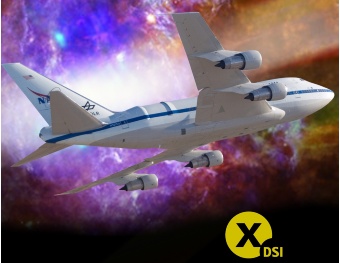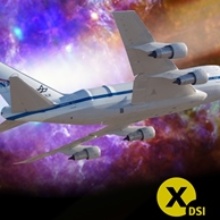-

- The airborne observatory SOFIA has already produced several scientific
- achievements. Copyrights: SOFIA - © NASA,
- Background - © ESA, Herschel Space Observatory.
On Nov. 25, 2014, the German SOFIA Institute (DSI) at the University of Stuttgart, celebrated its 10th anniversary with project partners, academic collaborators, and friends. The DSI was formed to support the development and operation of the Stratospheric Observatory for Infrared Astronomy (SOFIA), a joint project of NASA and the German Aerospace Center (DLR). The celebration included a series of lectures that gave an overview of the history of the DSI, the challenges and successes encountered during development, and concluded with a discussion of recent scientific achievements of the airborne observatory.
“When the University of Stuttgart – among several competitors – received the award to develop the German SOFIA Institute back in 2004, this was a major milestone for Stuttgart's renowned aerospace engineering faculty," said Prof. Wolfram Ressel, president of the university. “Since then, SOFIA has developed into a platform for interdisciplinary research that reaches far beyond aerospace subjects. With the 10th anniversary of the DSI we hope that the U.S. government will strongly ensure the budget of the project and hence the future of SOFIA.” Prof. Alfred Krabbe, who became director of the DSI in 2009, also sees an exciting future for the project, “On May 29, SOFIA was officially declared to have achieved Full Operation Capability, an event that is comparable to the launch of a satellite.”
Once the DSI was established, its staff was heavily involved in SOFIA's conversion from a
commercial jetliner into an airborne science platform. DSI engineers helped the SOFIA program meet
its initial milestones – first flight, first ground-based observations, first open-door flight –
and made significant contributions to the scientific "First Light" flight in May 2010, when the
observatory made its initial observations from altitude. DSI personnel have supported SOFIA's
science observations and the team was honored to have a significant role in the science papers
published in special editions of two renowned astrophysical journals (The Astrophysical Journal
Letters, April 20, 2012, and Astronomy and Astrophysics – GREAT Early Science Results. Vol. 542,
2012). Another highlight for the DSI was a series of nine scientific observation flights conducted
from New Zealand to investigate objects visible only from the southern hemisphere. SOFIA observed
the Magellanic Clouds and the Galactic Center with the German Receiver for Astronomy at Terahertz
Frequencies (GREAT) spectrometer.
Most recently, on Nov. 17, 2014, a paper based on SOFIA data was published in the prestigious
scientific journal Nature. This paper introduced a new method to determine the age of star-forming
regions. The discovery was made by a scientific team led by astronomers from the University of
Cologne, Germany, and was enabled by SOFIA's unique ability to collect data at far-infrared
wavelengths.
In December 2014, SOFIA completed a period of heavy maintenance that was conducted by Lufthansa Technik in Hamburg, Germany. This work has prepared SOFIA for continued science operations for years to come. The scientific programs for SOFIA's next observing cycle have been selected and the preparation of those flight plans is now underway. Plans for 2015 include another deployment to New Zealand – this time for five weeks, with two scientific instruments. Alfred Krabbe concluded his remarks at the anniversary celebration by saying, "SOFIA is back to science!"
For more information about SOFIA, visit:
http://www.nasa.gov/sofia • http://www.dlr.de/en/sofia
For information about SOFIA's science mission, visit:
http://www.sofia.usra.edu • http://www.dsi.uni-stuttgart.de/index.en.html
Contact:
Dr. Dörte Mehlert
Education and Public Outreach Lead
German SOFIA Institute
University of Stuttgart
Telephone: +49 (0)711 – 685 69632
Email: mehlert@dsi.uni-stuttgart.de
Nicholas A. Veronico
Public Affairs Officer
SOFIA Program Office and Science Center
NASA Ames Research Center
Moffett Field, CA 94035-0001
Telephone: +01 650-604-4589
Email: nveronico@sofia.usra.edu
| Contact | Dörte Mehlert, Email: mehlert@dsi.uni.stuttgart.de; Tel.:0711 - 685-69632 |
|---|


